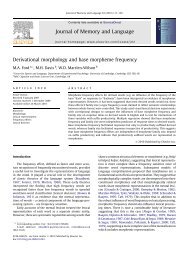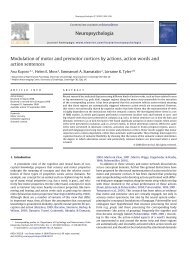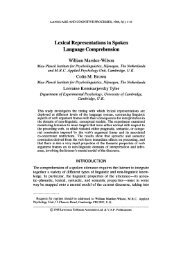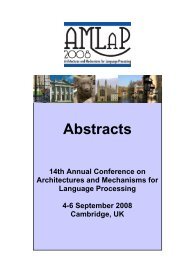Towards a psychological basis for a theory of anaphora - Centre for ...
Towards a psychological basis for a theory of anaphora - Centre for ...
Towards a psychological basis for a theory of anaphora - Centre for ...
Create successful ePaper yourself
Turn your PDF publications into a flip-book with our unique Google optimized e-Paper software.
(Identical Monitoring) the mean reaction-time in Normal<br />
Prose was 275 milliseconds. Subtracting 50-75<br />
milliseconds <strong>for</strong> actual response execution, this<br />
indicates that the subjects were able to start<br />
responding within about 200 milliseconds <strong>of</strong> the onset <strong>of</strong><br />
a word. And this is <strong>for</strong> words whose mean total duration<br />
was 370 msec (Marslen- Wilson & Tyler, 1980). Thus we<br />
are not only obtaining very fast responses, but also<br />
very early responses - in fact, at a point in a word<br />
where sufficient sensory input could not possibly have<br />
accumulated to allow the word to be correctly identified<br />
and responded to on that <strong>basis</strong> alone.<br />
This type <strong>of</strong> result (see also Marslen-Wilson &i<br />
Welsh, 1978) appears to <strong>for</strong>ce a model <strong>of</strong><br />
word-recognition in which contextual constraints<br />
interact directly with the selection <strong>of</strong> the correct<br />
word-candidate from among the set <strong>of</strong> candidates that are<br />
still compatible with the sensory input at the point at<br />
which these early recognition decisions are being made.<br />
This has two main implications. The first is that what<br />
is being accessed early in the recognition <strong>of</strong> a word<br />
cannot be just the set <strong>of</strong> phonological <strong>for</strong>ms associated<br />
with different word-candidates, but also the syntactic<br />
and semantic properties associated with them. Given<br />
this in<strong>for</strong>mation, the single correct word-candidate can<br />
be selected, on-line, as a function both <strong>of</strong> the<br />
accumulating sensory input and <strong>of</strong> the compatibility and<br />
incompatibility <strong>of</strong> the competing candidates with the<br />
contextual environment in which they are occurring.<br />
Thus, by the time a word has been recognised and,<br />
usually, be<strong>for</strong>e all <strong>of</strong> it will have been heard - the<br />
syntactic and semantic properties <strong>of</strong> that word will<br />
already have begun to<br />
propagation <strong>of</strong> the<br />
influence the development<br />
on-line interpretation <strong>of</strong><br />
and<br />
the<br />
utterance.<br />
The second implication is that the processing<br />
system is capable <strong>of</strong> analysing several competing<br />
word-hypotheses si~nul taneously, Syntactic and<br />
interpretative criteria need to be applied to<br />
potentially qui to largo sets <strong>of</strong> word-candidates; the<br />
rapid time-course <strong>of</strong> recognition processes, and evidence<br />
Prom experiments whlcl~ manipulate tho rrlza <strong>of</strong> tho aot <strong>of</strong><br />
potential candidates (c, E,, Marslen-Wilson, 1978;<br />
1980), indicate that these contextual assess~nents are<br />
carried out in parallell rather than sequentially and<br />
one at a time.<br />
To complete this sketch <strong>of</strong> the speech understanding<br />
process, we will briefly describe a second experiment<br />
that illustrates in a different way the interactions<br />
between knowledge sources that the process seems to<br />
permit. This experiment involved stimuli <strong>of</strong> the<br />
following types:






